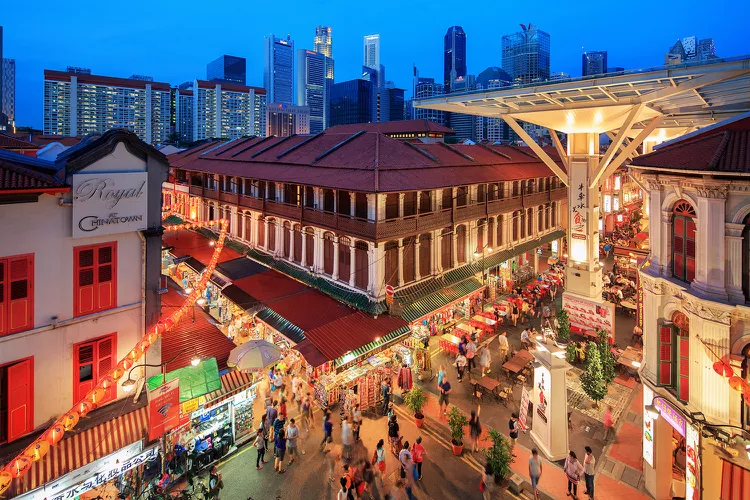Exploring Chinatown: A Shopper’s Paradise
Singapore’s Chinatown is the original Singapore, revitalized for tourists. The atmosphere has changed remarkably; the old street vendors and petty crime have been replaced with polished shophouses and bustling malls.
Originally, Chinatown served as a sanctuary for Chinese migrants who played a pivotal role in Singapore’s economy during the British colonial era. Historically, merchants sold various goods including cloth, gold, medicine, and traditional Chinese cuisine.
Although modernization has transformed the scenery, the essence of its narrow streets, two-story shophouses, and enchanting lanterns remains intact. Today, shoppers flock to Chinatown to spend their Singapore dollars on antiques, Chinese cultural memorabilia, and particularly on affordable hawker food. ($100 in Singapore can stretch surprisingly far.)
The shophouses are not just for souvenirs anymore; they are now home to various enterprises, including budget accommodations, advertising firms, jewelry shops, and T-shirt manufacturers. You will find an array of traditional crafts and Chinese medicine halls as well.
Chinatown is bordered by New Bridge Road, South Bridge Road, Upper Pickering Street, and Cantonment Road, making it easily accessible via MRT from Raffles Place, Outram Park, or Chinatown stations. (Explore how to navigate Singapore’s MRT and buses for convenience.)
Chinatown Street Market
Chinatown’s street market, located around Trengganu and Smith Streets (location on Google Maps), is the first shopping destination travelers encounter right across from the MRT exits.
The narrow lanes of Smith Street, Trengganu Street, Temple Street, Sago Lane, and Pagoda Street deliver Singapore’s most authentic street shopping experience, situated in what was once the island’s opium district.
Launched in 2004, the Street Market aims to replicate the traditional street hawker atmosphere of Chinatown, minus the litter and swindlers. Approximately 140 stalls line the streets, providing great opportunities for finding gray-market electronics, artisanal crafts, trendy fashion items, and unique antiques.
Notably, Smith Street is home to Chinatown Food Street, where visitors can savor Singapore’s most iconic dishes, ranging from laksa to roast duck to Hainanese chicken rice.
Stalls typically start selling by 10 am and close down at 10 pm, so it’s advisable to avoid peak hours at noon; instead, visit in the evening when the market transitions into an enchanting evening market illuminated by fairy lights.
People’s Park Centre
People’s Park Complex (1 Park Road, official site, location on Google Maps) boasts an eclectic mix of stores that offer traditional Chinese products as well as affordable contemporary items such as electronics, textiles, and jewelry. Simply walking through the market, visitors are bound to encounter religious icons, Chinese herbs, and an array of authentic Chinese cuisine.
For many locals, People’s Park is synonymous with nostalgia as it houses stores featuring old photographs and Chinatown memorabilia. Additionally, travel agencies and massage parlors operate within the complex.
While there are several cellphone and related shops here, they have garnered a reputation for dishonest services, leading to its characterization as the “most complained-about shopping center.” Thus, proceed with caution when shopping for electronics.

China Square Central
For those reminiscing about the past, China Square Central (18 Cross St., official site, location on Google Maps) offers its visitors a fascinating glimpse into nostalgia. One of its highlights is the popular China Square Central Flea Market, which operates on Sundays (9 am to 6 pm) within the main atrium, featuring a variety of kitschy and retro items such as comics, vintage appliances, antiques, and toys spanning two floors of the establishment.
Chinatown Point
Chinatown Point (133 New Bridge Road, official site, location on Google Maps) is hard to miss with its towering presence on New Bridge Road, boasting over 220 shops across five retail floors.
A particular highlight is the four-level Podium B, which hosts the Singapore Handicraft Centre. Here, visitors can discover an extensive range of handicrafts, including porcelain, bronze items, wooden carvings, paintings, antique furnishings, Chinese musical instruments, and intricate traditional embroidery.
Shoppers can also look forward to deals on watches, shoes, and cosmetics, with several affordable beauty salons located within Chinatown Point.

Ann Siang Hill
Ann Siang Hill is the last remnant of the hills that once dotted Chinatown. Two other hills were leveled in the 1890s to reclaim land from the sea. Today, Ann Siang Hill enjoys renewed popularity as a hub for boutique shopping brands. Streets like Ann Siang Road and Club Street are profuse with charming independent shops showcasing high-quality, unique apparel and accessories.
The historic shophouses along Ann Siang Hill now house brands leveraging the area’s nostalgic charm, featuring renowned shops like Aston Blake and Aster by Kyra, which specializes in Peranakan-inspired ceramics. As night falls, the area transforms with lively bars that attract a crowd looking to unwind.
Yue Hwa
Located at 70 Eu Tong Sen St., Yue Hwa (official site, location on Google Maps) is a Chinese-themed department store housed in a century-old building that was once the Nan Tin Hotel, Singapore’s first luxury hotel with an elevator.
Its award-winning renovation beautifully integrates architectural elements that enhance its historic value while preserving its essence. The six levels cater to the traditional Chinese shopper, offering goods such as medicinal herbs, textiles, porcelain, and a remarkable variety of teas and tea-making supplies.
While the prices at Yue Hwa may be higher than those found in market stalls, the quality justifies the cost. Special seasonal items, especially during Chinese New Year, have become popular among locals, attracting those in the know.





